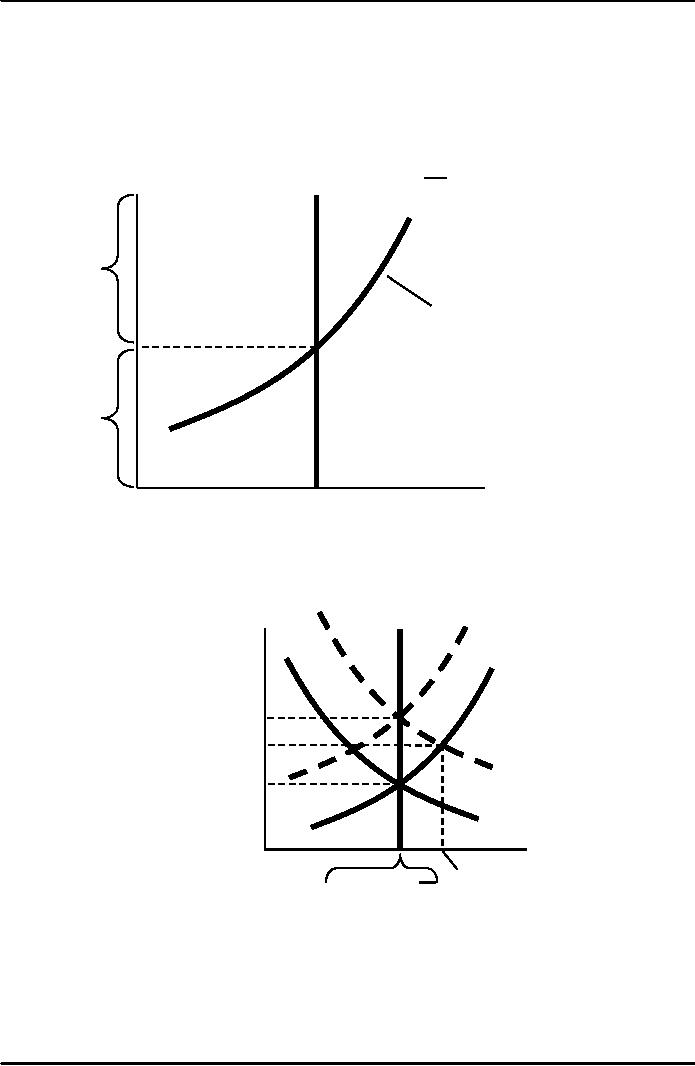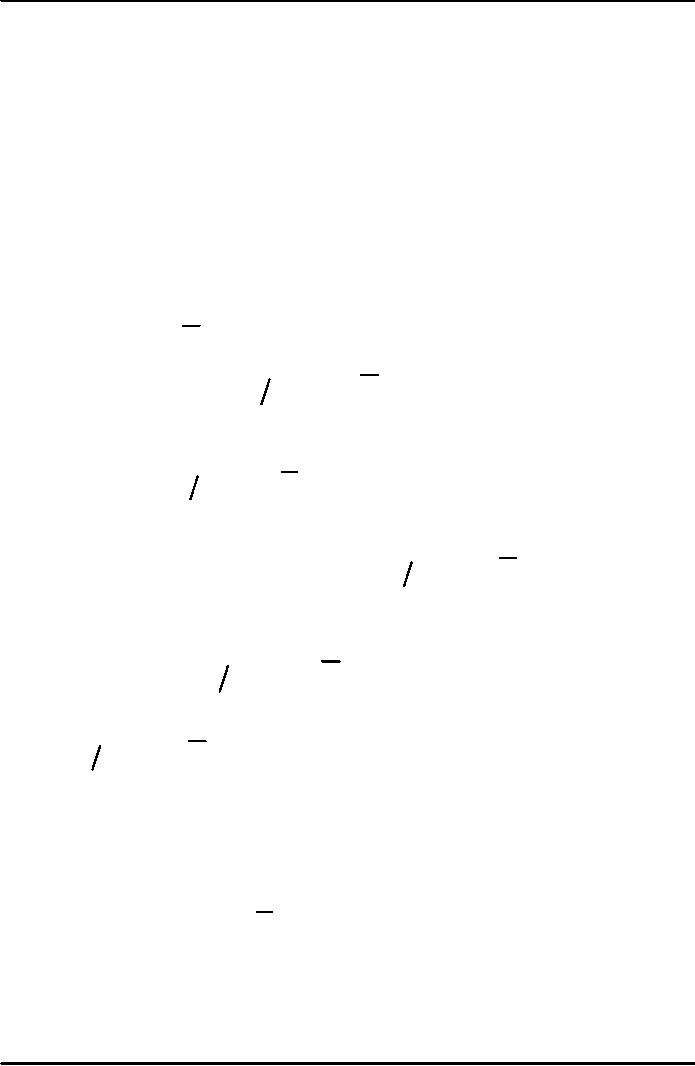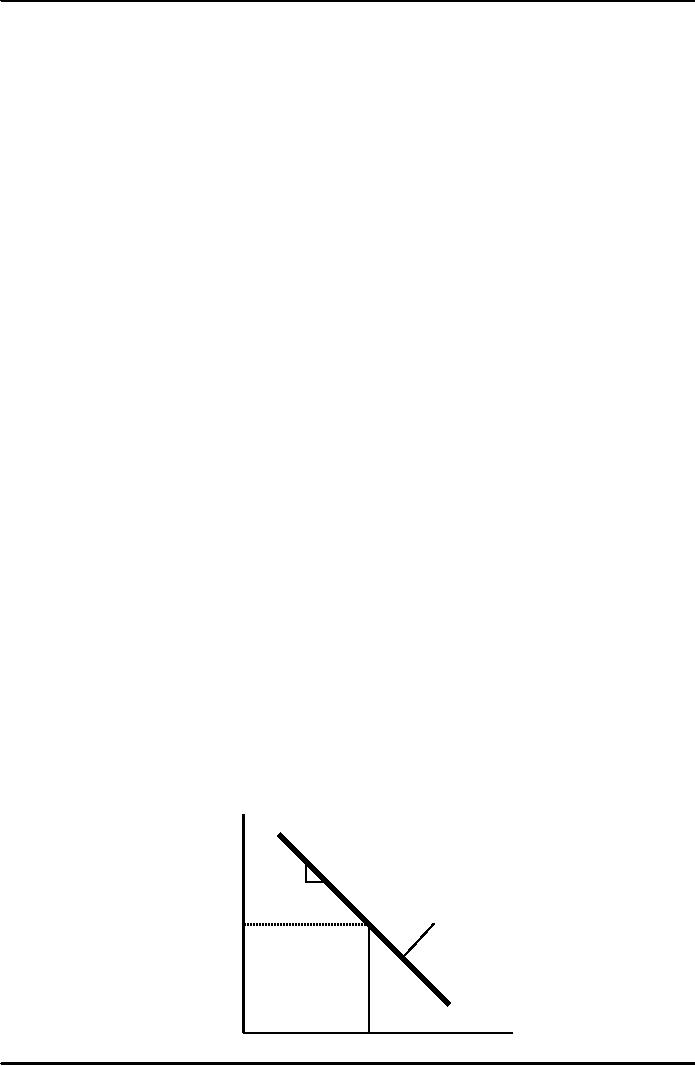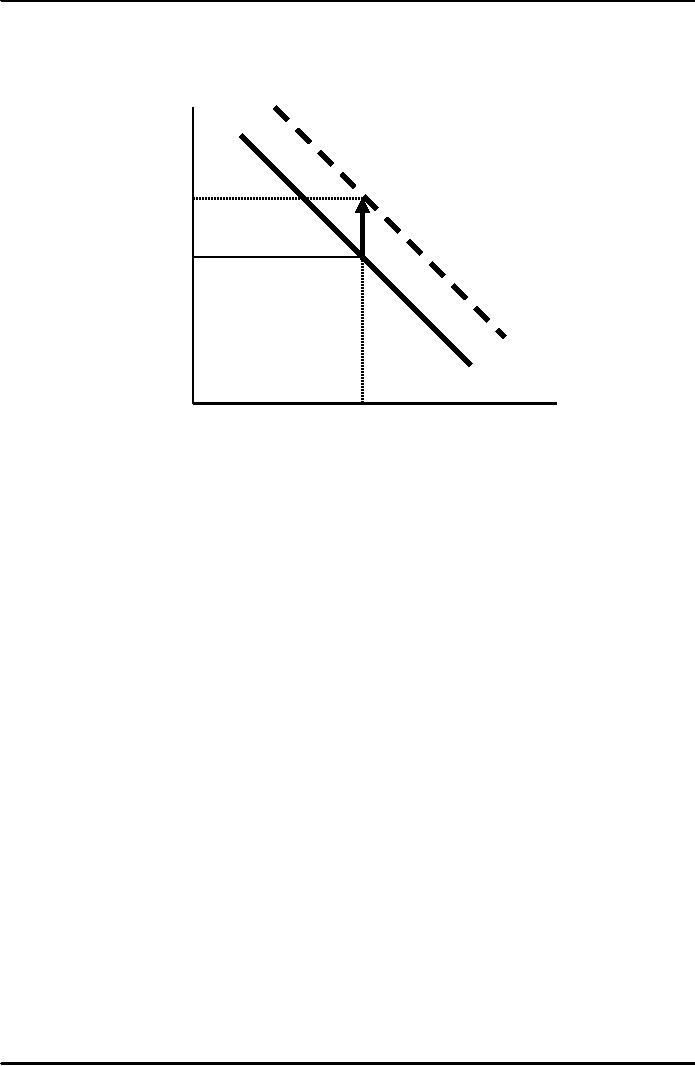 |
AGGREGATE SUPPLY (Continued…):Deriving the Phillips Curve from SRAS |
| << AGGREGATE SUPPLY:The sticky-price model |
| GOVERNMENT DEBT:Permanent Debt, Floating Debt, Unfunded Debts >> |

Macroeconomics
ECO 403
VU
LESSON
34
AGGREGATE
SUPPLY (Continued...)
Three
Models of Aggregate
Supply
Each
of the three models of
aggregate supply imply the
relationship summarized by the
SRAS
curve
& equation
P
LRAS
Y
=
Y
+
α(
-
P
)
e
P
>
Pe
P
SRAS
Pe
=
P
<P
e
P
Y
Y
Suppose
a positive AD
shock
moves output above its
natural rate and P
above
the level people
had
expected. Over time, P
e rises,
SRAS
shifts
up, and output returns to
its natural rate.
SRAS2
P
LRAS
SRAS1
e
P3 =
P
P2
AD2
e
e
P
2 =
P
1 =
P1
AD1
Y
Y
2
=Y
1 =
Y
Y
3
Inflation,
Unemployment, and the
Phillips Curve
The
Phillips curve states that
�
depends
on
�
Expected
inflation, �e
158

Macroeconomics
ECO 403
VU
�
Cyclical
unemployment: the deviation of
the actual rate of
unemployment from the
natural
rate
�
Supply
shocks, ν
�
= �
e
- β (u
- u
n ) +
ν
Where
β
>
0 is an exogenous constant.
Deriving
the Phillips Curve from
SRAS
The
Philips curve in its modern
form states that the
inflation rate depends on
three forces:
�Expected inflation.
�The deviation of
unemployment from the
natural rate, called
cyclical unemployment.
�Supply shocks.
We
can drive the Philips
curve from our equation
for aggregate supply.
Y
= Y
+ α (P
- P
e )
(1)
According
to aggregate supply
equation:
P
= P
e + ( 1 α
)
(Y -Y
)
(2)
Here
are the three steps.
First, add to the right-hand
side of the equation a
supply shock v to
represent
exogenous events (such as
change in world's oil
prices) that alter the
price level and
shift
the short run aggregate
supply curve:
P
= P
e + ( 1 α
)
(Y -Y
) +
ν
(3)
Next,
to go from the price level
to inflation rates, subtract
last year's price level P
-1
from
both
sides of equation to
obtain
(P
- P-1
) =
( P
e - P-1
) +
(1 α
)
(Y -Y
) +
ν
(4)
The
term on the left hand
side is the difference
between current price level
and last years
price
level,
which is inflation. The term
on the right hand side is
the difference between the
expected
price
level and last years
price level, which is
expected inflation.
Therefore,
�
= �
e
+ ( 1 α
)
(Y -Y
) +
ν
(5)
Now
to go from output to unemployment,
recall Okun's law which
gives a relationship
between
two
variables. We can write this
as
(1
α
)
(Y -Y
) =
- β (u
- u
n )
(6)
Using
this Okun's law
relationship, we can substitute
left-hand side value in
equation number
5,
and we obtain
e
n
�
= �
- β (u
- u
) +
ν
(7)
The
Phillips Curve and SRAS
Y
= Y
+ α (P
- P
e )
SRAS:
�
= �
e
- β (u
- u
n ) +
ν
Phillips
curve:
�
SRAS
curve:
output
is related to unexpected movements in
the price level
159

Macroeconomics
ECO 403
VU
�
Phillips
curve:
unemployment
is related to unexpected movements in
the inflation rate
Adaptive
expectations
�
Adaptive
expectations: an approach that
assumes people form their
expectations of future
inflation
based on recently observed
inflation.
�
A
simple example:
Expected
inflation = last year's
actual inflation
�
e
= � -1
Then,
theP.C.becomes
�
n
�
= �
-1 -
β (u
- u
) +
ν
Inflation
inertia
�
In
this form, the Phillips
curve implies that inflation
has inertia:
In the
absence of supply shocks or
cyclical unemployment, inflation
will continue
indefinitely
at its current rate.
Past
inflation influences expectations of
current inflation, which in
turn influences the
wages
& prices that people
set.
Two
causes of rising & falling
inflation
�
Cost-push
inflation: inflation resulting
from supply shocks. Adverse
supply shocks
typically
raise
production costs and induce
firms to raise prices,
"pushing" inflation
up.
�
Demand-pull
inflation: inflation resulting
from demand shocks. Positive
shocks to aggregate
demand
cause unemployment to fall
below its natural rate,
which "pulls" the inflation
rate
up.
Graphing
the Phillips
curve
In
the short run, policymakers
face a trade-off between � and
u.
�
β
1
The
short-run Phillips
e
�
ν
+
Curve
u
un
160

Macroeconomics
ECO 403
VU
Shifting
the Phillips
curve
People
adjust their expectations
over time, so the tradeoff
only holds in the short
run. e.g., an
increase
in �e
shifts
the short-run P.C.
upward.
�
�
e
+ν
e
�1 +ν
u
un
The
sacrifice ratio
�
To
reduce inflation, policymakers
can
contract
aggregate demand,
causing
unemployment
to rise above the natural
rate.
�
The
sacrifice ratio measures the
percentage of a year's real
GDP that must be foregone
to
reduce
inflation by 1 percentage
point.
�
Estimates
vary, but a typical one is
5.
�
Suppose
policymakers wish to reduce
inflation from 6 to 2 percent. If
the sacrifice ratio is
5,
then
reducing inflation by 4 points
requires a loss of 4�5 = 20 percent
of one year's GDP.
�
This
could be achieved several
ways, e.g.
Reduce GDP by
20% for one
year
Reduce GDP by
10% for each of two
years
Reduce GDP by
5% for each of four
years
�
The
cost of disinflation is lost GDP.
One could use Okun's
law to translate this cost
into
unemployment.
Rational
expectations
Ways
of modeling the formation of
expectations:
�
Adaptive
expectations:
People
base their expectations of
future inflation on recently
observed inflation.
�
Rational
expectations:
People
base their expectations on
all available information,
including information
about
current
a& prospective future
policies.
161

Macroeconomics
ECO 403
VU
Painless
disinflation?
�
Proponents
of rational expectations believe
that the sacrifice ratio
may be very small:
�
Suppose
u = u n and �
= �e
= 6%, and
suppose the central bank
announces that it will
do
whatever
is necessary to reduce
inflation
from
6 to 2 percent as soon as
possible.
�
If
the announcement is credible,
then �e
will
fall, perhaps by the full 4
points.
�
Then,
�
can
fall without an increase in
u.
The
natural rate
hypothesis
Our
analysis of the costs of
disinflation, and of economic
fluctuations in the
preceding
chapters,
is based on the natural rate
hypothesis:
Changes
in aggregate demand affect
output and employment only
in the short run.
In
the long run, the
economy returns to the
levels of output, employment,
and unemployment
described
by the classical
model
An
alternative hypothesis:
hysteresis
�
Hysteresis:
the
long-lasting influence of history on
variables such as the
natural rate
of
unemployment.
�
Negative
shocks may increase u n, so
economy may not fully
recover:
The
skills of cyclically unemployed
workers deteriorate while
unemployed, and they
cannot
find a job when the
recession ends.
Cyclically
unemployed workers may lose
their influence on wage-setting;
insiders
(employed
workers) may then bargain
for higher wages for
themselves. Then, the
cyclically
unemployed "outsiders" may
become structurally unemployed
when the
recession
ends.
162
Table of Contents:
- INTRODUCTION:COURSE DESCRIPTION, TEN PRINCIPLES OF ECONOMICS
- PRINCIPLE OF MACROECONOMICS:People Face Tradeoffs
- IMPORTANCE OF MACROECONOMICS:Interest rates and rental payments
- THE DATA OF MACROECONOMICS:Rules for computing GDP
- THE DATA OF MACROECONOMICS (Continued…):Components of Expenditures
- THE DATA OF MACROECONOMICS (Continued…):How to construct the CPI
- NATIONAL INCOME: WHERE IT COMES FROM AND WHERE IT GOES
- NATIONAL INCOME: WHERE IT COMES FROM AND WHERE IT GOES (Continued…)
- NATIONAL INCOME: WHERE IT COMES FROM AND WHERE IT GOES (Continued…)
- NATIONAL INCOME: WHERE IT COMES FROM AND WHERE IT GOES (Continued…)
- MONEY AND INFLATION:The Quantity Equation, Inflation and interest rates
- MONEY AND INFLATION (Continued…):Money demand and the nominal interest rate
- MONEY AND INFLATION (Continued…):Costs of expected inflation:
- MONEY AND INFLATION (Continued…):The Classical Dichotomy
- OPEN ECONOMY:Three experiments, The nominal exchange rate
- OPEN ECONOMY (Continued…):The Determinants of the Nominal Exchange Rate
- OPEN ECONOMY (Continued…):A first model of the natural rate
- ISSUES IN UNEMPLOYMENT:Public Policy and Job Search
- ECONOMIC GROWTH:THE SOLOW MODEL, Saving and investment
- ECONOMIC GROWTH (Continued…):The Steady State
- ECONOMIC GROWTH (Continued…):The Golden Rule Capital Stock
- ECONOMIC GROWTH (Continued…):The Golden Rule, Policies to promote growth
- ECONOMIC GROWTH (Continued…):Possible problems with industrial policy
- AGGREGATE DEMAND AND AGGREGATE SUPPLY:When prices are sticky
- AGGREGATE DEMAND AND AGGREGATE SUPPLY (Continued…):
- AGGREGATE DEMAND AND AGGREGATE SUPPLY (Continued…):
- AGGREGATE DEMAND AND AGGREGATE SUPPLY (Continued…)
- AGGREGATE DEMAND AND AGGREGATE SUPPLY (Continued…)
- AGGREGATE DEMAND AND AGGREGATE SUPPLY (Continued…)
- AGGREGATE DEMAND IN THE OPEN ECONOMY:Lessons about fiscal policy
- AGGREGATE DEMAND IN THE OPEN ECONOMY(Continued…):Fixed exchange rates
- AGGREGATE DEMAND IN THE OPEN ECONOMY (Continued…):Why income might not rise
- AGGREGATE SUPPLY:The sticky-price model
- AGGREGATE SUPPLY (Continued…):Deriving the Phillips Curve from SRAS
- GOVERNMENT DEBT:Permanent Debt, Floating Debt, Unfunded Debts
- GOVERNMENT DEBT (Continued…):Starting with too little capital,
- CONSUMPTION:Secular Stagnation and Simon Kuznets
- CONSUMPTION (Continued…):Consumer Preferences, Constraints on Borrowings
- CONSUMPTION (Continued…):The Life-cycle Consumption Function
- INVESTMENT:The Rental Price of Capital, The Cost of Capital
- INVESTMENT (Continued…):The Determinants of Investment
- INVESTMENT (Continued…):Financing Constraints, Residential Investment
- INVESTMENT (Continued…):Inventories and the Real Interest Rate
- MONEY:Money Supply, Fractional Reserve Banking,
- MONEY (Continued…):Three Instruments of Money Supply, Money Demand